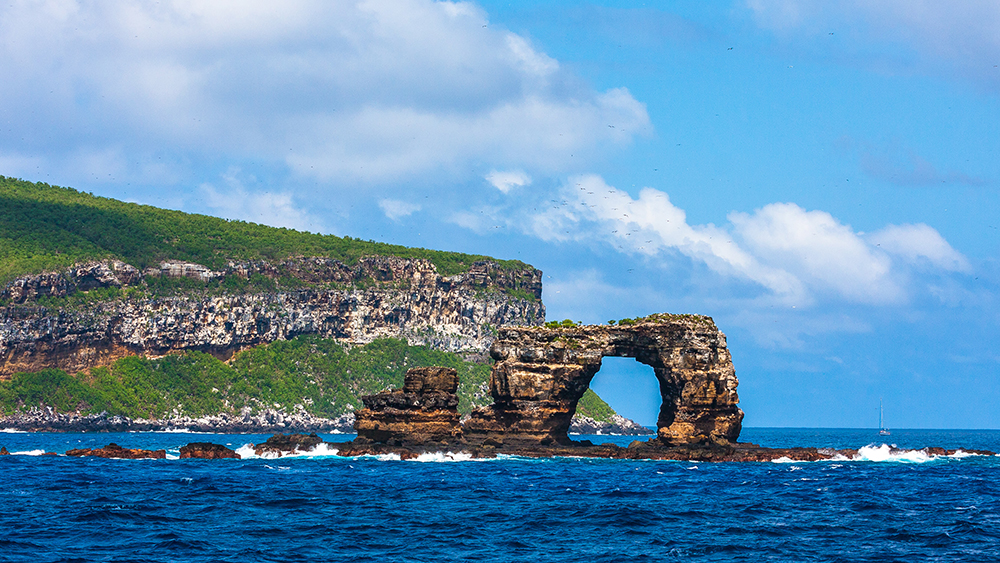Natural stone arches are commonly made of sandstone or limestone and are found in coastal cliff areas that can be eroded by wave action. Other arches have also formed as artifacts of the receding phase of the Flood.1
Over the centuries, arches form due to erosion where softer rock is removed, producing alcoves and leaving harder caprock at the top. Sometimes, these result in arches. Through unrelenting erosion, even the caprock erodes and will ultimately cause collapse of these seemingly timeless features.
The Metate Arch composed of sandstone is very thin and is near the end of its life. It’s found in Devils Garden of the Grand Staircase-Escalante Monument in south-central Utah. One can appreciate the erosional processes at work. Not only wind carves the rock, but also the cycle of heat and cold causes cracks in the softer sandstone, eroding it away, and leaving the caprock.
“Rainbow Arch, located just above the visitor center in Arches National Park, collapsed sometime this winter. A park ranger noticed it was no longer standing during a hike in February.”2
In May of 2021, a well-known geological feature called Darwin’s Arch off the coast of the Galapagos Islands succumbed to various forces and has collapsed into the Pacific Ocean.3
There are other geologic features that have yielded to continuous erosion.
The Great Stone Face, also called the Old Man of the Mountain in New Hampshire, was composed of five granite cliff ledges, which, when viewed from the north, looked like the profile of a human face. It was first noted by a surveying team in 1805. It collapsed on May of 2003.
“A massive sheet of rock has fallen from the vertical face of the Half Dome in Yosemite National Park, making one of the most popular routes attempted by climbers in North America even more challenging, park officials said...The granite sheet that peeled off measured roughly 100 by 200 feet.”4
Supposedly, the White Cliffs of Dover were formed in the Cretaceous many millions of years ago. Evolutionists estimate a paltry 0.39” of erosion per year. But there has been significant fracturing of the cliffs every decade or so. In 2001, a huge chunk fell into the English Channel followed by another large section in March 2012. A huge portion of the White Cliffs broke off and fell into the Channel February third of 2021. This recent collapse saw tons of chalk break off near Samphire Hoe Country Park. Eyewitnesses say they heard a 'loud crack,' before swathes of rock fell into the sea.5
We’re seeing a lot—too much—catastrophic erosion of these magnificent cliffs over a short time. At this observed erosion rate, there wouldn’t be any White Cliffs of Dover in much less than a million years.
Observed erosional processes do a lot of geologic work that doesn’t require millions or even hundreds of thousands of years.
Not only can today’s weathering processes account for the collapse of arches and other exposed features, but lightning can cause significant weathering in bare rock settings, such as mountaintops. An article in LiveScience quoted Knight, saying,
"Lightning is very significant in causing landscape erosion and the formation of lots of fractured bedrock," Knight told LiveScience's OurAmazingPlanet. "What I think this project does, in highlighting the role of lightning, is go some way toward overturning a very entrenched and long-held paradigm of how many continental scale landscapes have evolved."
And,
"Often people studying these regions have assumed they are just sitting there, they're not changing very much," Knight said. "Our study shows that we can have quite dramatic changes over the time scale of a single lightning strike. These mountains are far more dynamic, and changing far more quickly, than we realized."6
Once again, we see slow and gradual uniformitarianism (“the present is the key to the past”) fails to account for these examples of rapid erosion. Rather than relying on human wisdom-based processes, Bible-based catastrophism7 is a much better perspective within which to interpret the rapid destruction of Earth’s exposed rock, cliffs, and arches.
References
- Thomas, B. and Clarey, T. 2023. Park Across America. Dallas, TX: Institute for Creation Research.
- Admin Writer. Arch Collapse in Arches National Park (Rainbow Arch). Natural Arches. Posted on naturalarches.org May 2, 2018, accessed April 3, 2023.
- Galapagos Islands: Erosion fells Darwin’s Arch. BBC. Posted on bbc.com May 18, 2021, accessed April 3, 2023.
- Science Writer. Yosemite Rock Fall Makes Climbing Half Dome More Difficult. Wall Street Journal. Posted on wsj.com July 7, 2015, accessed April 3, 2023.
- Peat, J. Large chunks of White Cliffs of Dover collapse into the sea. The London Economic. Posted on thelondoneconomic.com February 4, 2021, accessed April 3, 2023.
- Oskin, B. Electrocution: New Way to Erode Mountains. LiveScience. Posted on livescience.com Oct 25, 2013, accessed April 4, 2023.
- Clarey, T. 2020. Carved in Stone: A New Flood Model. Acts & Facts. 49 (5): 5.














